
Embracing Serenity: Designing a Japanese-Style Living Room with Minimalist Shelves
In a world that frequently enough feels cluttered and chaotic, the pursuit of tranquility has never been more essential. Enter the Japanese-style living room, a sanctuary of simplicity that invites calmness into our daily lives. This design ethos, deeply rooted in minimalism and harmony with nature, encourages us to create spaces that reflect our inner peace. At the heart of this aesthetic lies the power of thoughtfully designed minimalist shelves—functional yet unobtrusive elements that not only organize but also enhance the overall ambiance. In this article, we will explore the key principles of embracing serenity through the art of Japanese design, showcasing how minimalist shelving can transform your living room into a serene retreat. Prepare to discover the beauty of less as we embark on a journey toward creating a space that embodies tranquility and intentionality.
Embracing Natural Light in Your Japanese-style Living Room Design
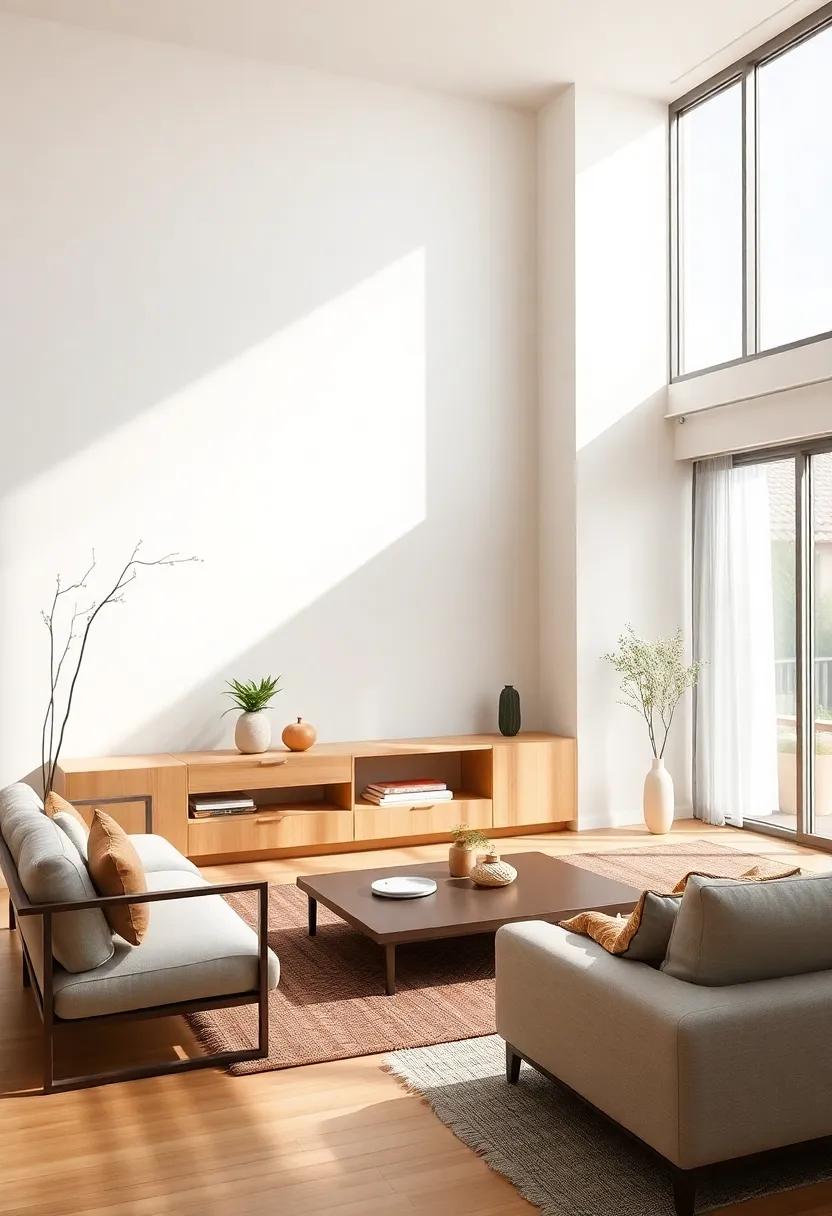
Incorporating natural light into a Japanese-style living room is basic to achieving a tranquil and serene ambiance. Large windows or sliding glass doors not only frame the outside landscape but also invite sunlight to cascade through the space. Choosing light, sheer curtains allows for soft diffusion of sunlight, maintaining privacy while still embracing the changing patterns of light throughout the day. optimal placement of mirrors can enhance this effect, reflecting the gentle glow of daylight and creating an illusion of expanded space.
When arranging your furniture, consider low-profile seating that allows unobstructed views toward windows, fostering a seamless connection with nature. The simplicity of minimalist shelves, which can be made from natural woods or bamboo, complements this aesthetic beautifully while showcasing handpicked decor items or plants. Embrace elements such as stone lanterns or traditional pottery to draw the eye to natural textures, and incorporate greenery through potted plants that thrive in natural light, adding an organic touch that enriches the overall harmony of the living area.
The Harmony of Colors: Earthy Tones and Subtle Hues in Minimalism
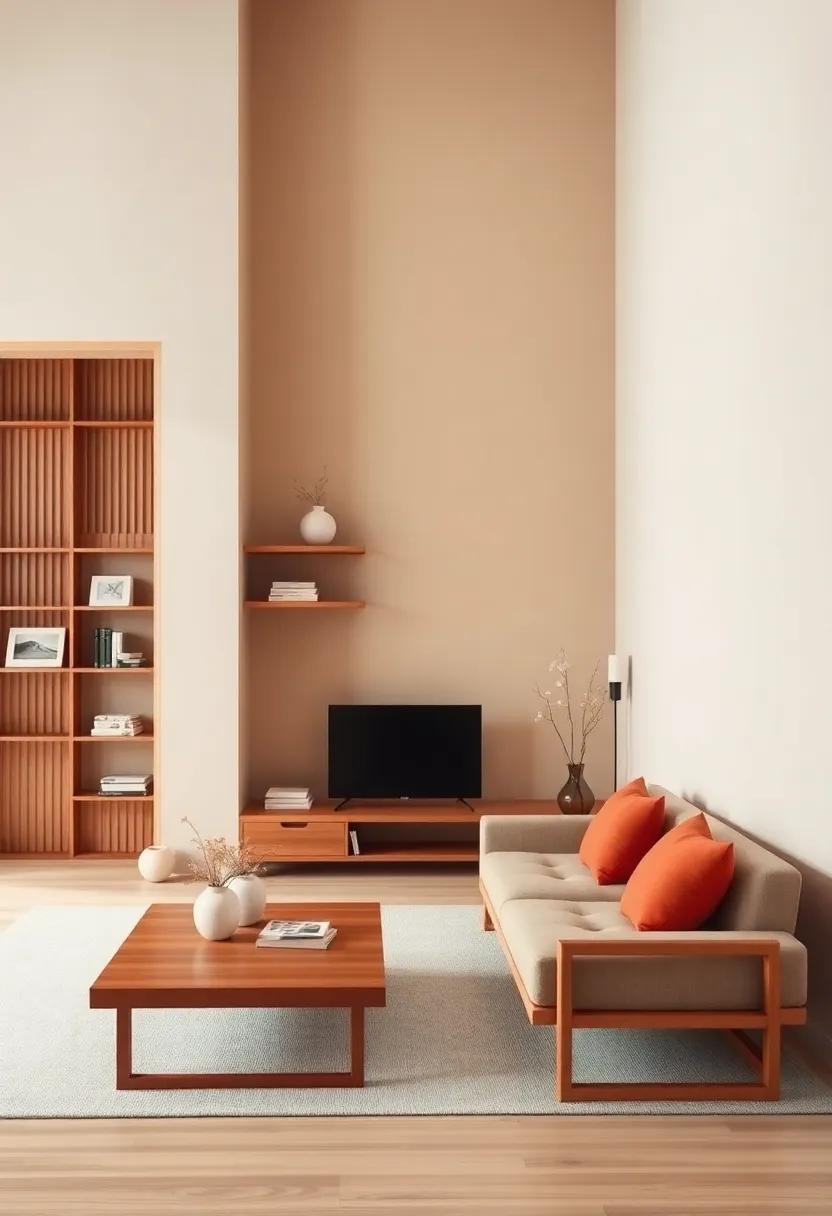
In a serene Japanese-style living room, the thoughtful use of earthy tones and subtle hues creates a peaceful retreat. By embracing colors inspired by nature, such as soft greens, warm browns, and muted grays, you foster a calming atmosphere that invites relaxation. Minimalist shelves, designed to blend seamlessly into this aesthetic, can showcase decorative objects while maintaining the focus on simplicity and openness. Consider materials like bamboo or reclaimed wood for your shelving, which not only echo the organic feel but also add texture without overwhelming the space.
To maintain this tranquil vibe, it’s essential to select a cohesive color palette that enhances the natural light within the room. Highlighting the beauty of a minimalist approach, incorporate a few carefully curated elements, such as:
- Natural textiles: Linen cushions or cotton throws in earthy neutrals
- Plants: Soft green succulents or bonsai to breathe life into your space
- Art pieces: Subtle ink paintings or crafted ceramics to add a personal touch
The combination of these elements fosters a harmonious balance, ensuring that each item plays a role in promoting serenity and elegance throughout the design.
Incorporating Natural Elements: Wood and Stone Textures in Decor
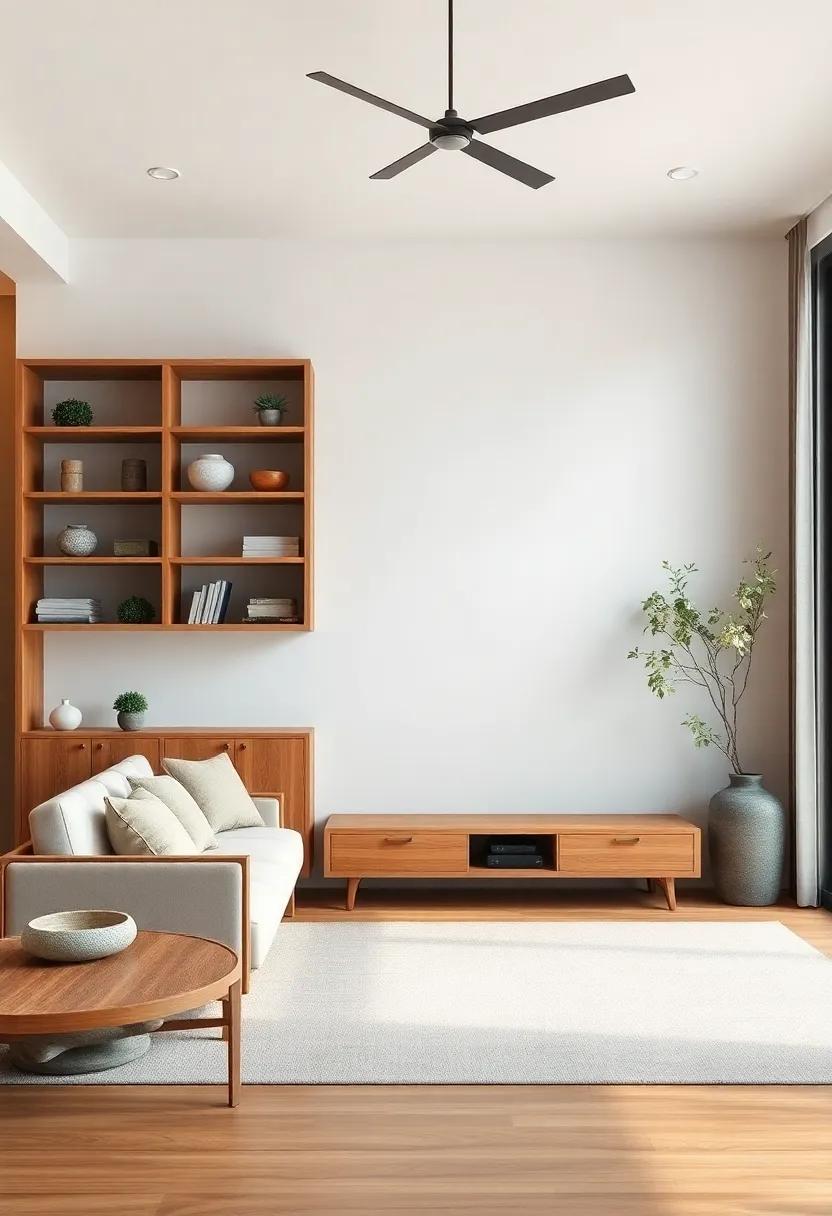
To achieve a harmonious environment that reflects the tranquility of nature, incorporating wood and stone textures is essential. The use of natural wood elements,such as bamboo or reclaimed timber,can add warmth and depth to your living space. Consider choosing pieces like an elegant low coffee table or minimalist shelving that showcases the beauty of the wood grain. Similarly, stone accents—be it a subtly textured feature wall or decorative stone planters—can enhance the organic feel. These materials not only create a visual connection to the natural world but also evoke feelings of stability and grounding,perfect for a serene atmosphere.
To further enhance the aesthetic, aim for a balance between these elements and the overall minimalist beliefs. A carefully curated selection of decor items can help maintain clarity and calm in the room. Consider the following tips to harmonize wood and stone textures in your design:
- Opt for a neutral color palette to allow the textures to stand out.
- Incorporate indoor plants in ceramic or stone pots to add a sense of life.
- Use wood-based furniture that emphasizes clean lines without excess ornamentation.
- Layer rugs made from natural materials like jute or wool to bring warmth underfoot.
By thoughtfully integrating these elements, you’ll create a living room that not only embodies the essence of Japanese design but also invites serenity and mindfulness into your daily life.
Creating a Zen Atmosphere: The Role of Plants in Your Space
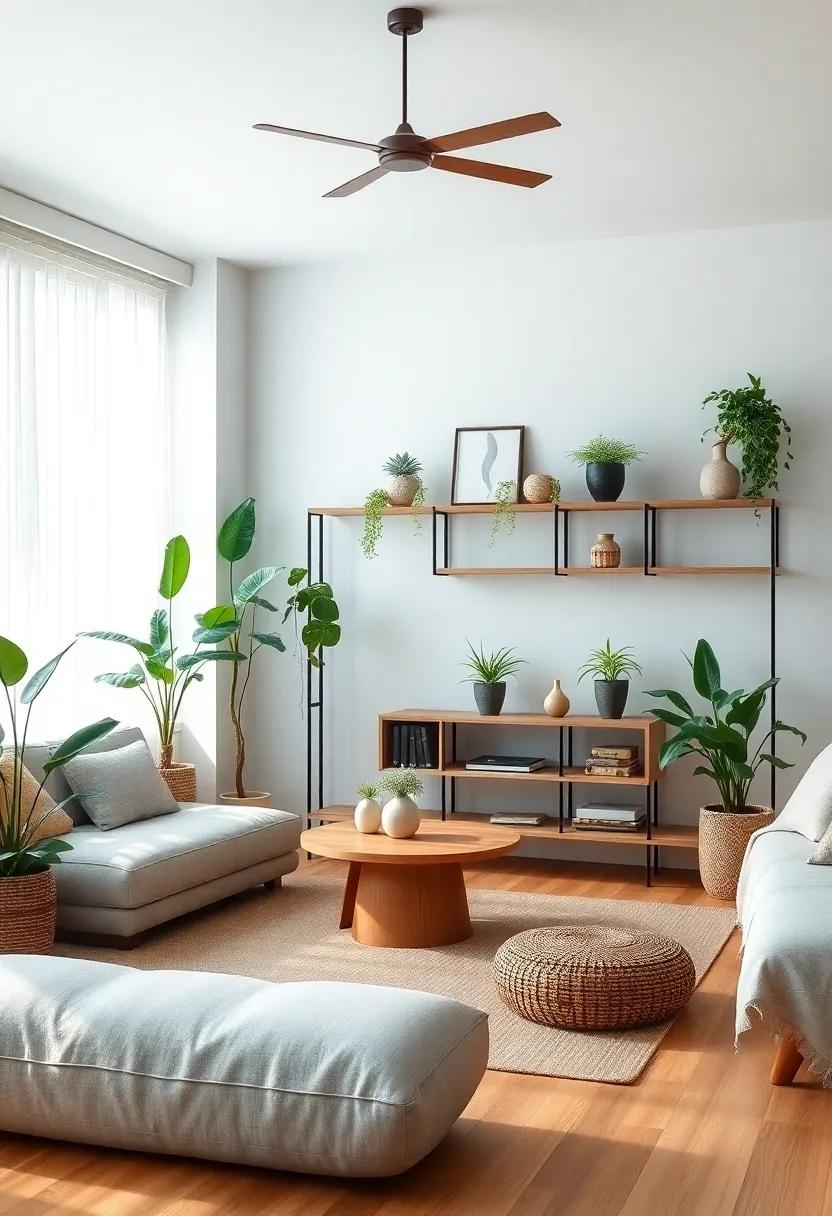
To cultivate a sense of serenity in your living space, incorporating plants is crucial. Greenery not only adds visual interest but also promotes tranquility and balance, essential principles in Japanese design. Here are some ideal plants to consider for your minimalist shelves:
- Bonsai Trees: Symbolic of harmony and patience, they serve as a central focal point.
- Snake Plants: With thier upright leaves, they create a striking vertical element.
- Pothos: A cascading beauty that softens hard edges and brings a touch of nature indoors.
- Japanese Maple: If space allows, this tree’s delicate leaves create a stunning visual appeal.
When placing plants, consider their placement in relation to light and scale, ensuring they harmonize with the minimalist aesthetic. Using simple, elegant pots further enhances the calm vibe of the space. Below is a simple guide for plant care that complements your design ethos:
| Plant | Light Requirement | Watering Frequency |
|---|---|---|
| Bonsai | indirect sunlight | Every 2-4 weeks |
| Snake Plant | Low to bright light | Every 3 weeks |
| Pothos | Low to moderate light | Every 2 weeks |
| Japanese Maple | Partial shade | Weekly |
The Art of Simplicity: Choosing Furniture with Clean Lines
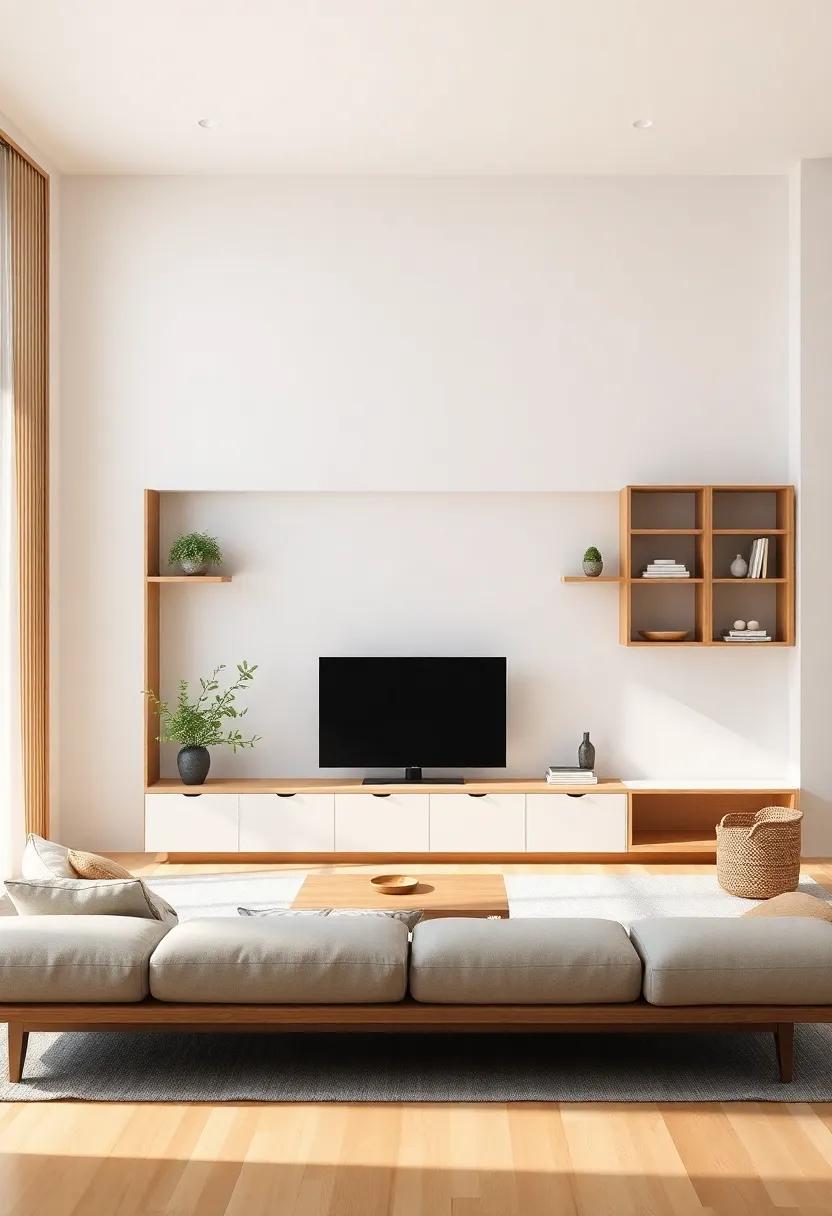
Selecting furniture that embraces simplicity involves a careful balance between aesthetics and functionality. Clean lines not only contribute to a tranquil environment but also allow each piece to tell its story without overwhelming the senses. when choosing your furniture, consider options that embody minimalism, where form follows function. Materials like light woods, soft textiles, and unobtrusive metal accents align beautifully with the serene Japanese aesthetic and invite an air of peace into your living space.
Focus on pieces that offer both beauty and utility. Here are a few elements to consider for attaining the right look:
- Low-profile sofas: These can create an open space and offer horizontal lines that enhance the feeling of tranquility.
- simple coffee tables: Opt for designs with minimal ornamentation, such as a solid wood slab or a tempered glass top.
- Open shelving: Select shelving units that maximize vertical space without making the room feel cluttered.
| Furniture Piece | Material | Style |
|---|---|---|
| Sofa | Natural Wood, Linen | Low-Profile |
| Coffee Table | Glass, oak | Minimalist |
| Shelving Unit | Bamboo | Open Design |
Mindful Arrangements: The Layout for Tranquility and Flow
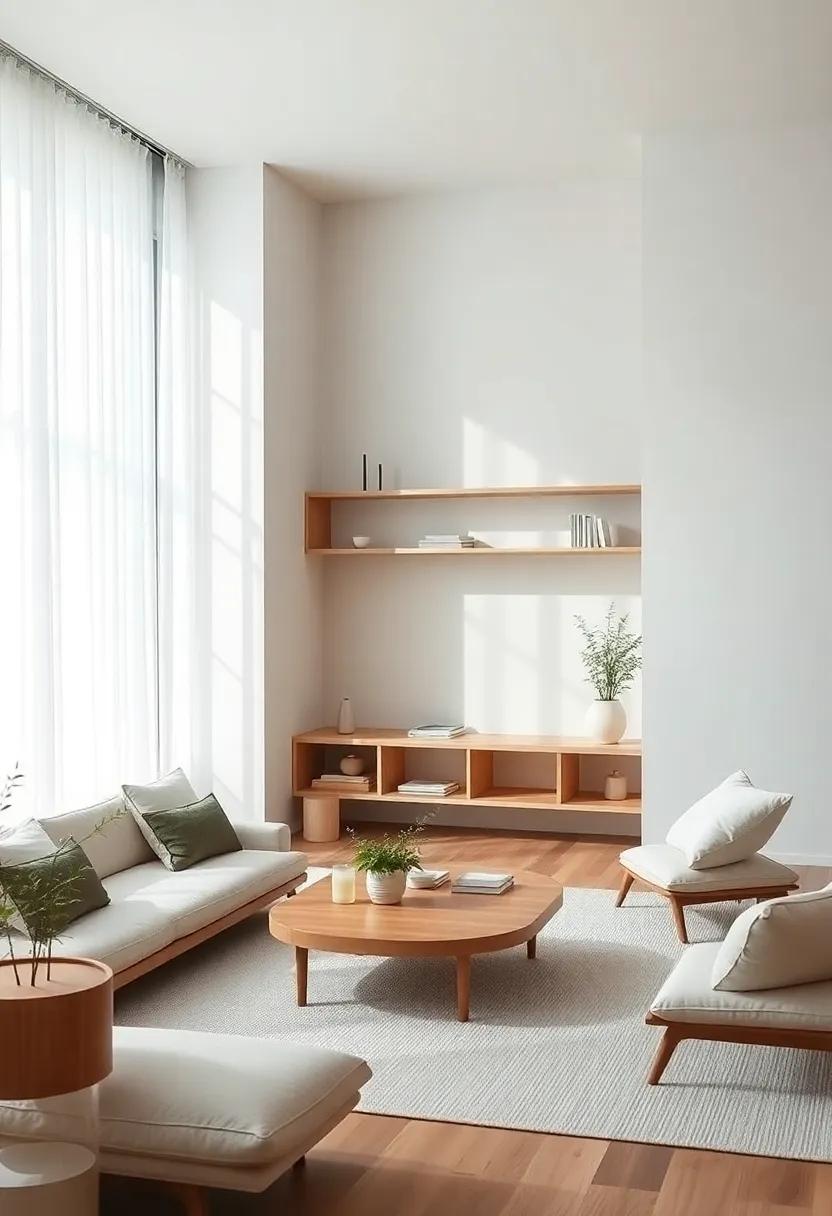
Achieving a serene ambiance in your living space can be accomplished by carefully considering your layout.In a Japanese-style living room, the arrangement of furniture and décor plays a pivotal role in promoting tranquility and flow. Start by integrating minimalist shelves that allow for a clean and uncluttered look, yet offer functionality. These shelves can serve as a subtle display for select books, cherished souvenirs, or natural elements like bonsai and stones, all arranged to draw the eyes around the room without overwhelming the senses. Emphasize open spaces by avoiding bulky furniture, which can obstruct movement and disrupt the harmony of the room.
To further enhance the sense of balance and calm,consider the following elements when designing your layout:
- Natural Light: Position seating to face windows,ensuring ample sunlight brightens the space.
- Flooring: Use tatami mats or soft rugs to encourage a sense of warmth and comfort underfoot.
- Color Palette: Opt for muted tones—greens, browns, and soft whites—to mimic nature and create a soothing environment.
Incorporating these mindful arrangements fosters a flow that is not only visually appealing but also promotes relaxation and mental clarity. By placing elements in a way that encourages ease of movement and natural light, you create a living room that embodies the principles of Japanese design, offering a sanctuary from the chaos of daily life.
Crafting a Focal Point: Minimalist Shelves as a highlight
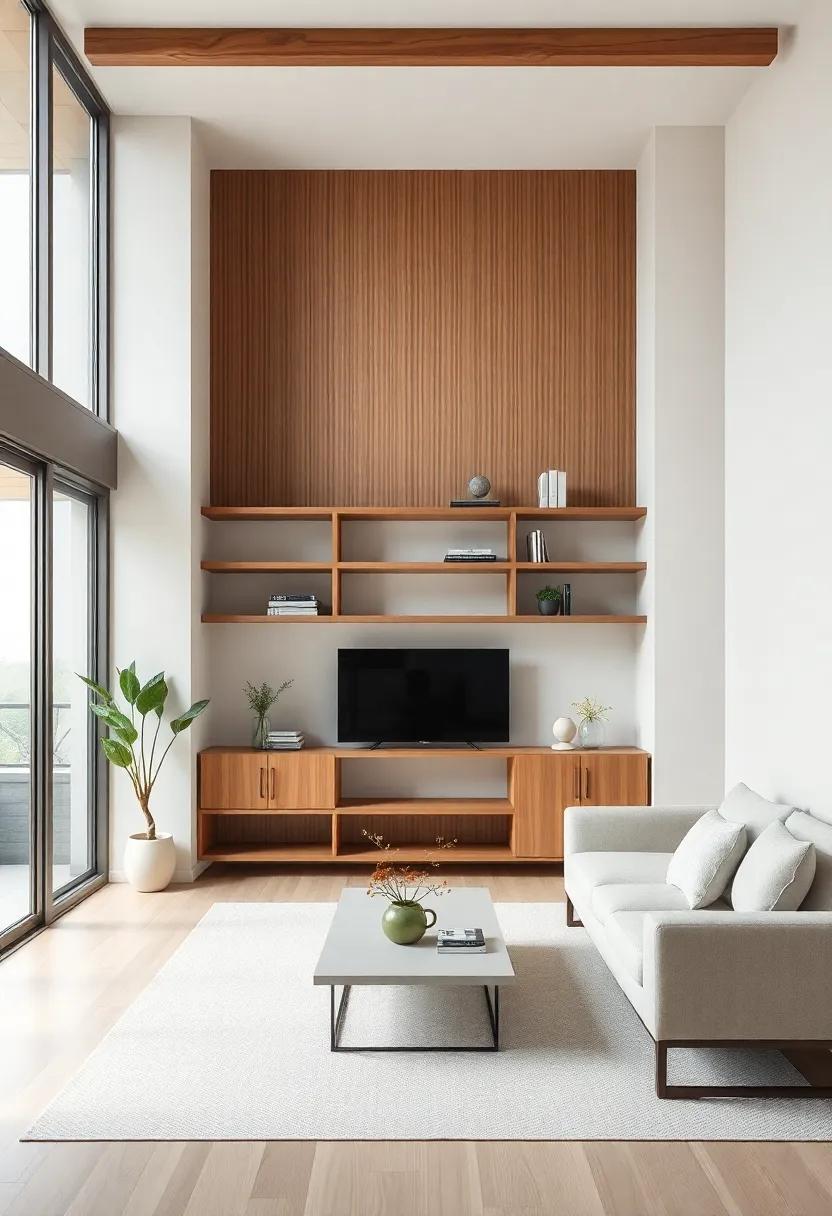
In a japanese-style living room, minimalist shelves can serve as both functional storage and a captivating focal point. By selecting clean lines and natural materials, these shelves can enhance the serenity of the space while showcasing carefully curated items. Consider displaying a harmonious blend of the following:
- Elegant ceramics
- Thoughtfully arranged plants
- Artful books
- Traditional japanese decorations
To accentuate the beauty of your minimalist shelves, maintain a balanced arrangement that incorporates negative space, allowing the eye to rest and appreciate each piece. Utilize a neutral palette for the shelves, which complements the calming aesthetics of a Japanese living room. Pair your shelves with subtle lighting to highlight particular items and create a warm ambiance that invites relaxation.
| Element | Purpose |
|---|---|
| Plants | Add life and a natural touch |
| Ceramics | Introduce cultural heritage and craftsmanship |
| Books | Encourage a mindset of learning and tranquility |
| Art | Provide visual interest and inspiration |
Selecting the Right Materials: Sustainable Choices for a Pure Aesthetic
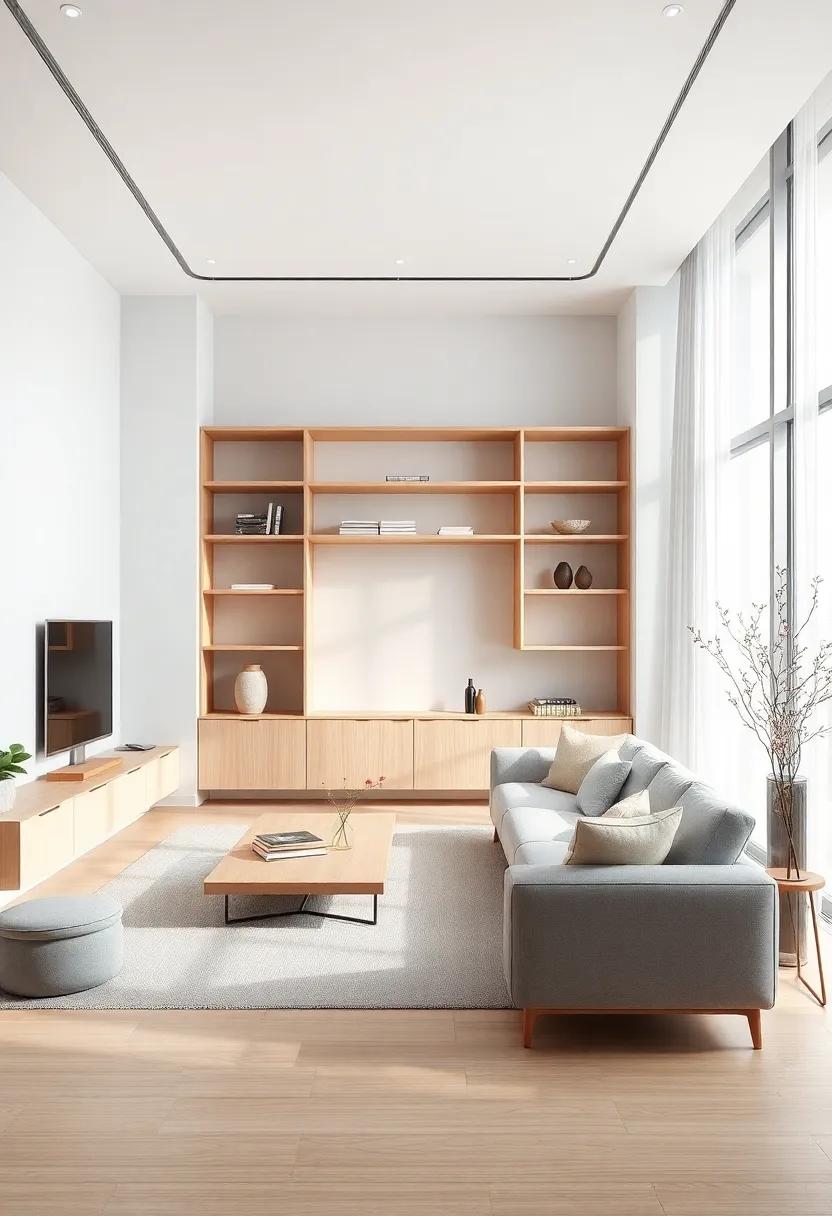
When curating your japanese-style living room, selecting sustainable materials is essential to uphold the serenity and purity that define this aesthetic. Look for options that not only reflect simplicity but also resonate with environmental consciousness. Consider using:
- Bamboo: Known for its rapid growth and renewability, bamboo makes for stunning shelving and flooring.
- Reclaimed Wood: By repurposing older timber, you create a unique story in your space while minimizing environmental impact.
- Natural Fabrics: Opt for organic cotton, linen, or wool for cushions and throws to introduce warmth and softness without harmful chemicals.
Moreover, incorporating non-toxic finishes can further enhance the beauty of your living space. A minimalist design frequently enough allows furniture to stand out, and choosing the right materials can elevate that experience. Here’s a simple comparison of some sustainable material options:
| Material | Benefits |
|---|---|
| Bamboo | Eco-kind, durable, and stylish |
| Reclaimed wood | Unique character, reduces waste, and sturdy |
| Natural Fabrics | Soft, breathable, and non-toxic |
Balancing Functionality and Beauty: The Purpose of Each Piece
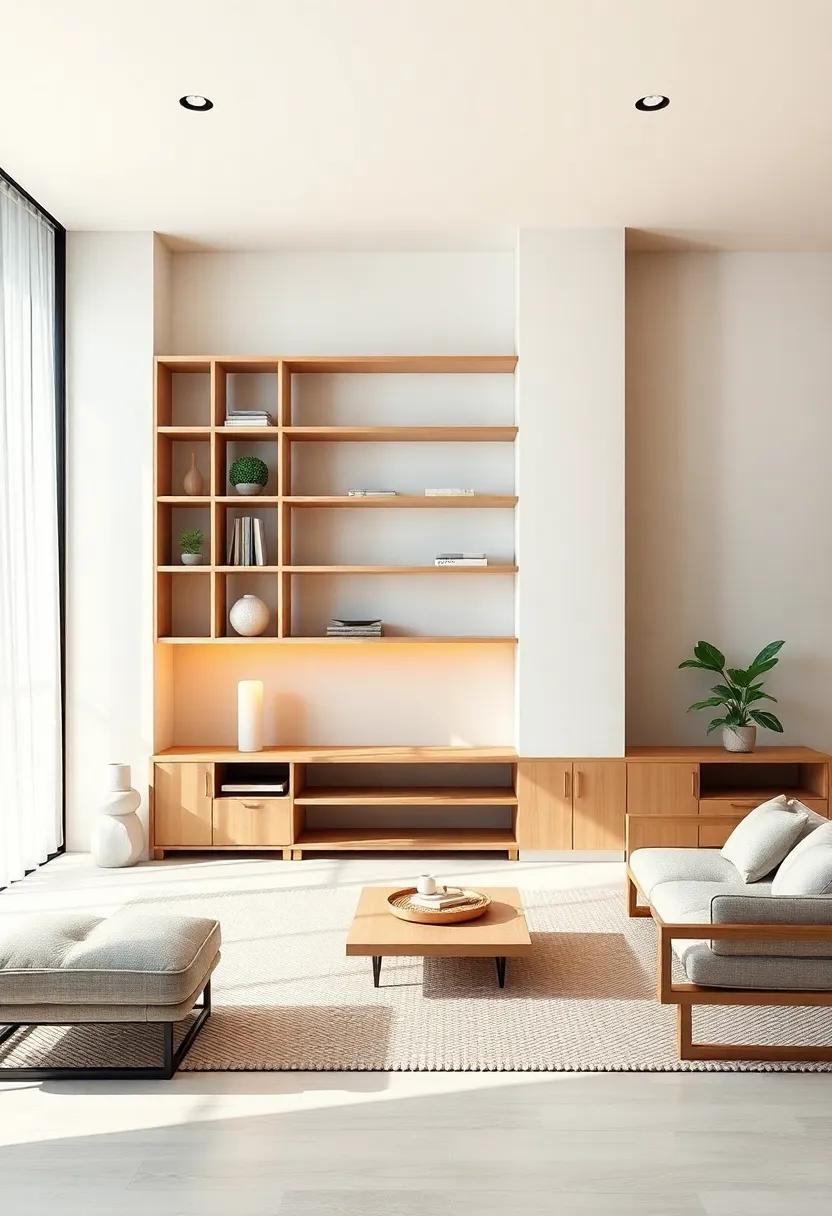
In a Japanese-style living room, every piece of furniture is carefully selected to uphold harmony and balance, emphasizing the dual role of functionality and beauty. Minimalist shelves serve as a quintessential element, not just for storage but also as a canvas for showcasing curated decor. Each item displayed should contribute to a sense of tranquility and intentionality, reflecting the owner’s personality while adhering to the principles of simplicity. When choosing the contents for your shelves,consider incorporating:
- Natural Elements: Incorporate plants or bonsai trees to bring life and color.
- Ceramics: Display handmade pottery or artisanal bowls that offer texture and culture.
- Books: Include a few well-loved books that enrich the space both visually and intellectually.
- Essential Items: Choose functional, yet aesthetically pleasing objects that serve a purpose.
To maintain a sense of calm, it is indeed vital to balance visual weight across the shelves, ensuring no single area appears crowded. This can be achieved by utilizing various shelf heights and widths and by alternating between light and dark-colored items. below is a simple guide to help you assess the visual impact of your shelf arrangement:
| Visual Elements | recommended Approach |
|---|---|
| Height Variation | Create a dynamic look with both tall and short items. |
| Color Balance | Mix neutral tones with pops of color for interest. |
| Negative Space | Leave blank spaces to avoid visual clutter. |
Textiles That Comfort: Choosing fabrics for a Soothing Environment
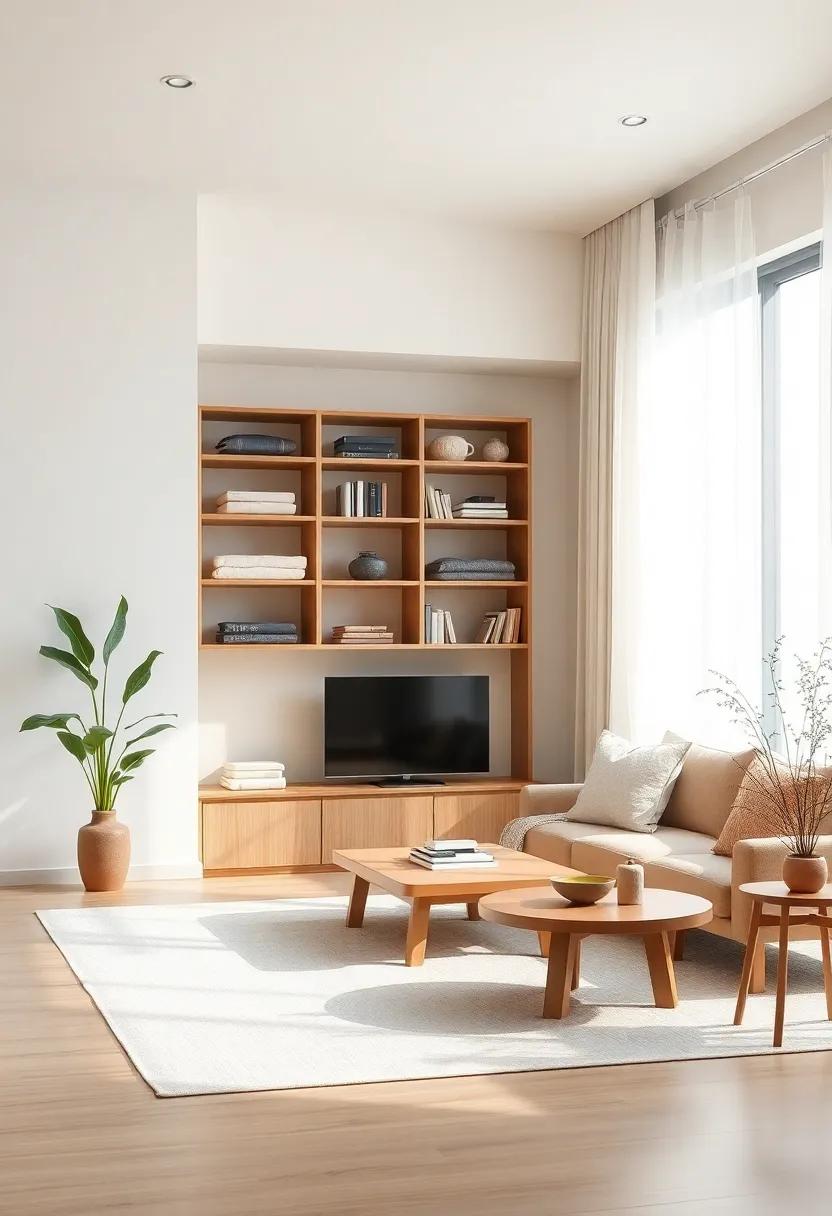
Creating a soothing environment in a Japanese-style living room requires a thoughtful selection of textiles that promote comfort and tranquility. Incorporating natural materials is key; consider using cotton, linen, and silk. These fabrics not only feel gentle against the skin but also enhance the overall aesthetic. Look for items such as:
- Futons - Soft and supportive, ideal for minimalist seating or bedding.
- woven rugs - Add warmth and texture while remaining visually light.
- Lightweight curtains - Provide privacy without overwhelming the space.
Additionally, color and pattern play a crucial role in fabric selection. Opt for calming hues like soft whites, muted greens, and earthy browns to reflect a sense of peace. Subtle patterns such as geometric designs or floral motifs can also bring life to a room while maintaining coherence with the minimalist theme. To visualize your choices, consider the following table of recommended fabrics:
| fabric Type | Texture | Color Palette |
|---|---|---|
| Cotton | Soft, breathable | Earthy tones |
| Linen | textured, light | Pale pastels |
| Silk | Luxurious, smooth | Rich jewel tones |
Creating a Cozy Nook: Reading Spaces within Minimalist Design

To cultivate a reading space that harmonizes with minimalism,consider the balance of simplicity and comfort. Start by choosing a strategically placed chair or cushion that invites relaxation. Opt for soft textures like muted linens or natural fabrics that resonate with a serene aesthetic. Incorporate natural light where possible, using sheer window treatments to create a bright yet tranquil atmosphere. Surround your reading nook with subtle decor pieces, such as a small potted plant or an elegant side table, to maintain focus without overwhelming the senses.
A key element to an effective reading nook is the use of minimalist shelving, which not only acts as a repository for your favorite books but also enhances the overall design of the room. Use open shelves to create a sense of airiness and avoid clutter. Consider adding a few carefully chosen decorative items that complement the books, such as ceramic vases or handcrafted wooden pieces, to maintain aesthetic harmony. A well-organized shelf can display reading materials alongside simple art pieces, ensuring that your nook remains a calm retreat, encouraging you to immerse yourself in literature while embracing the beauty of minimalist design.
Art and Decor: Choosing Meaningful Pieces for Your Shelves
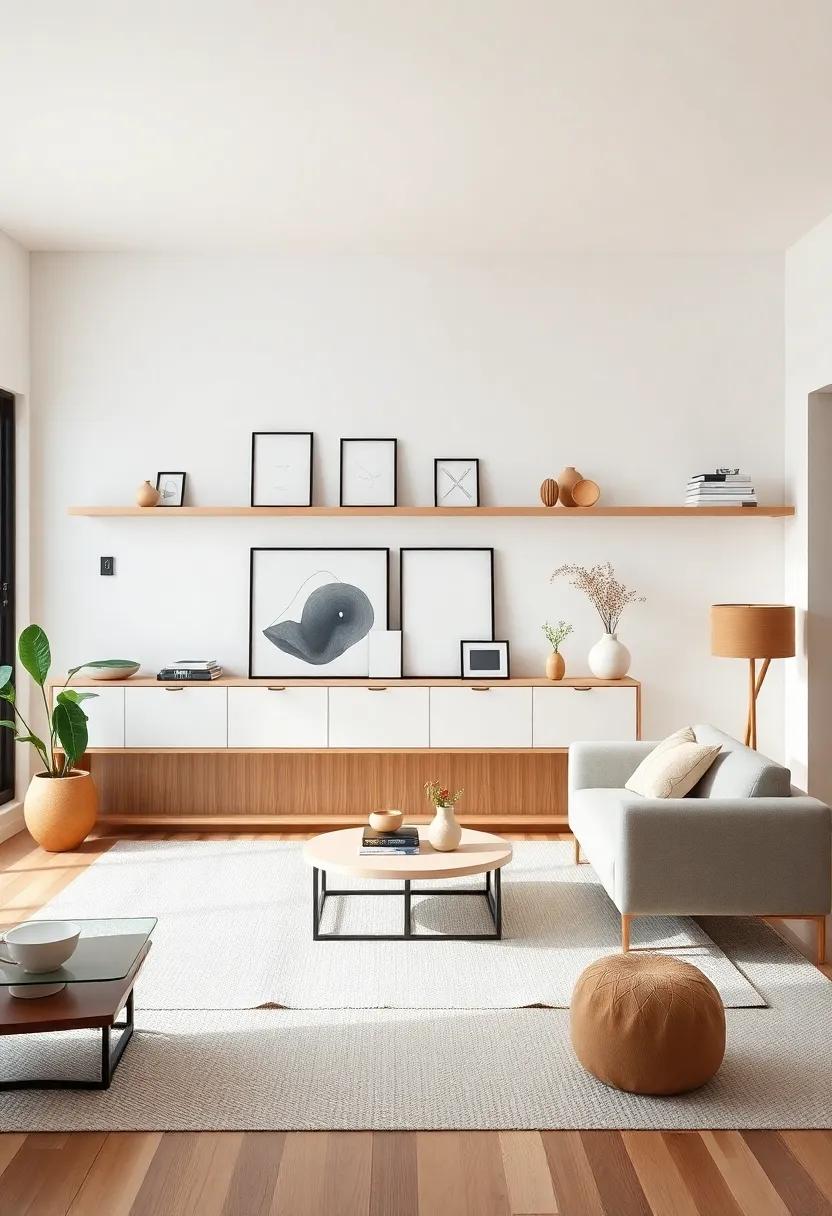
In a serene Japanese-style living room, every decorative piece tells a story.When selecting art and decor for your shelves, prioritize items that resonate with simplicity and meaning. Consider incorporating natural elements such as:
- Handcrafted ceramics - Each piece reflects the artist’s individual style and the beauty of imperfection.
- Bamboo or wooden artifacts – These materials instill a sense of warmth and connection to nature.
- Minimalistic sculptures – Opt for forms that evoke tranquility and provoke thoght.
Choose items that align with your personal narrative and enhance the overall ambiance. A well-placed calligraphy scroll or a traditional Japanese doll can serve as a focal point, inviting contemplation.To harmonize the aesthetic further, organize your decor by considering the principles of balance and proportion. You might organize your shelves as follows:
| Item Type | Position | Effect |
|---|---|---|
| Artistic Bowl | center Shelf | Create a focal point |
| Framed Prints | Upper Shelf | Add height and interest |
| Small Plants | Side corners | Introduce life and color |
The Elegance of negative Space: Allowing Your Design to Breathe

In the world of design,negative space can transform a room from cluttered to serene,crafting a sanctuary that invites calmness and introspection. By allowing areas of emptiness to coexist with carefully selected objects, you enable the eye to appreciate each detail thoroughly. This principle is notably resonant in a Japanese-style living room, where simplicity is elevated and balance is paramount. Elemental features such as a meticulously placed shoji screen or a single tatami mat can be enhanced by the surrounding space, encouraging a mindfulness that permeates the environment.
To achieve this harmonious atmosphere, consider incorporating minimalist shelves that exemplify functionality without overwhelming the senses. These shelves should be understated, perhaps made from natural materials like bamboo or light-colored wood, promoting a sense of warmth while still retaining openness. When styling these shelves, opt for a few essential decor pieces—think ceramic vases or subtle artwork—each selected for their symbolic meaning in Japanese culture. By adhering to the principle of less is more, each item can tell a story, surrounded by generous spaces that evoke tranquility.
Incorporating Asian Influences: Decorative Elements with Purpose
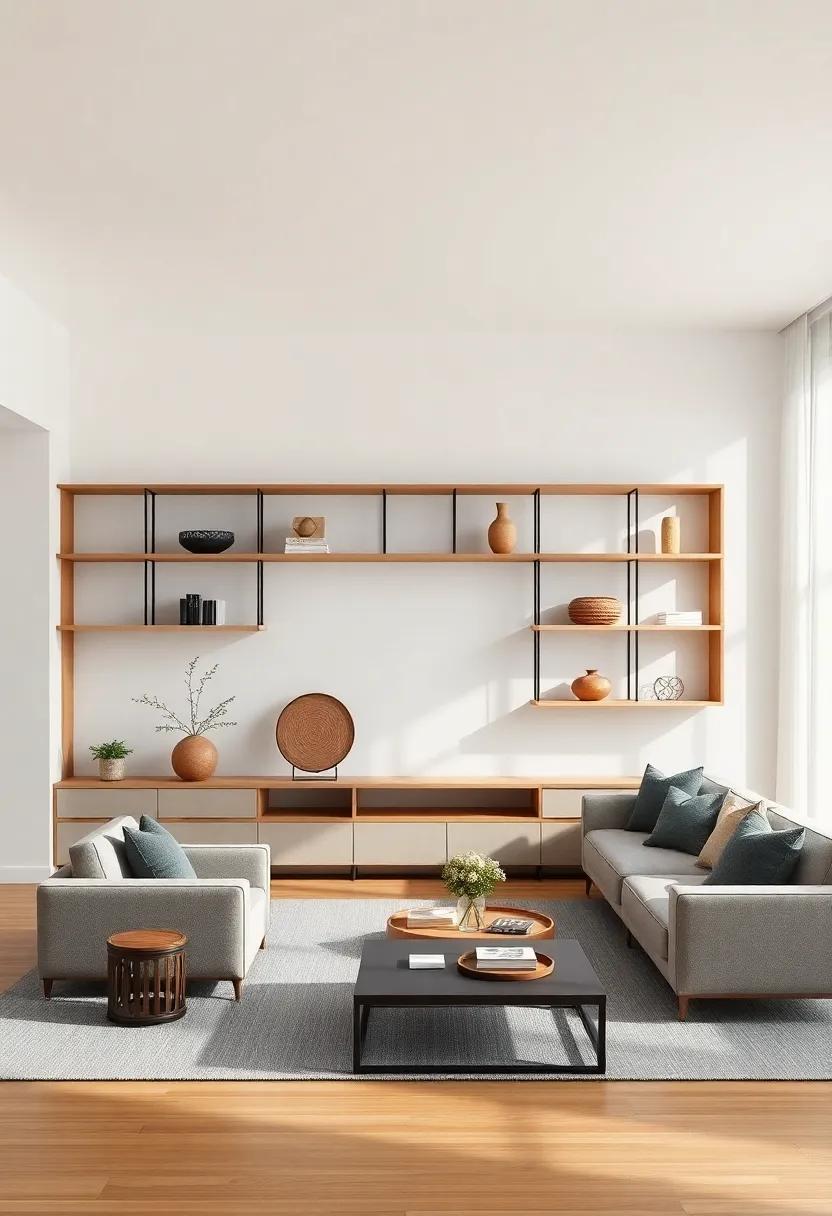
When transforming your living space into a haven of tranquility, the incorporation of Asian decorative elements can be both intentional and impactful.Each piece serves not only as an aesthetic enhancement but also as a reflection of the deeper philosophical principles inherent in Asian cultures. Consider integrating the following features to create a harmonious living room:
- Natural Materials: Use wood, bamboo, and stone to evoke a connection with nature.
- Lanterns: Soft lighting from traditional paper lanterns can create a serene ambiance.
- Simple Artwork: Minimalist paintings or calligraphy can serve as focal points without overwhelming the senses.
- Textiles: Incorporate cushions and throws in muted colors that promote relaxation.
functional decor is key in a Japanese-style living room, where every object serves a purpose while contributing to the overall aesthetic. A carefully curated selection of items can enhance the minimalist ethos. Consider displaying your essential books and cherished mementos on sleek, minimalist shelves that maintain visual simplicity but are rich in cultural meaning.Enhance this backdrop with a small table to showcase seasonal flower arrangements or a calming tea set:
| Element | Purpose |
|---|---|
| Books | Encourage learning and reflection |
| Art | Inspire creativity and peace |
| Plants | Add life and promote well-being |
| Tea Set | Encourage mindfulness and relaxation |
Building a Flowing Energy: Importance of Open Spaces in design
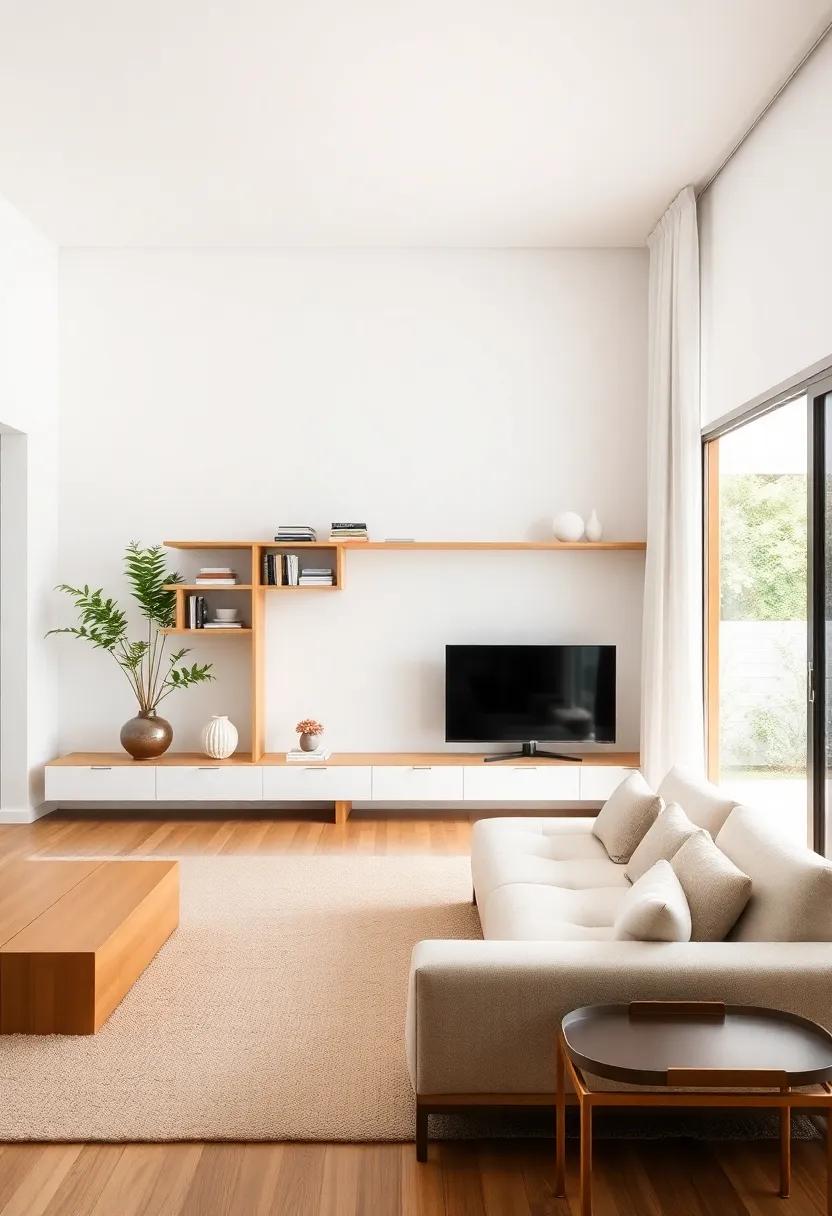
Creating open spaces in a living room is essential for fostering a sense of tranquility and balance. in a Japanese-style design, the flow of energy is paramount, guiding the user through the space in a manner that promotes relaxation and mindfulness. Natural light plays a crucial role, streaming through large windows or sliding doors, which not only illuminates the space but also blurs the boundaries between the indoor and outdoor environments. Emphasizing natural materials such as wood, stone, and textiles enhances this connection, encouraging harmony with nature.
When integrating minimalist shelves into your design, consider the following elements to achieve that fluid energy:
- Simplicity: Opt for sleek lines and understated designs that don’t overwhelm the space.
- Functionality: Ensure that each shelf serves a purpose, displaying only essential items that resonate with personal meaning.
- Negative Space: Leave ample empty space around objects to enhance visual breathing room and promote focus.
A well-organized shelving unit can serve as a focal point, creating a sense of structure while also allowing the space to breathe. To illustrate this concept, the following table summarizes the balance of design elements effectively:
| Design Element | Impact |
|---|---|
| Natural Materials | Promote warmth and tranquility |
| Open Layout | Enhances flow and spaciousness |
| minimalist Decor | Encourages mindfulness and focus |
Lighting for Serenity: The Influence of Soft, Ambient Lighting
The key to fostering a peaceful atmosphere in a Japanese-style living room lies in the use of soft, ambient lighting.This type of lighting creates a warm, inviting environment that encourages relaxation and reflection. Consider incorporating dimmable fixtures, which allow for a range of brightness levels depending on the time of day or mood desired. The gentle glow from floor lamps or strategically placed wall sconces can highlight the minimalist decor and natural materials, providing a harmonious balance that promotes a sense of calm.
To enhance the tranquil vibe further, you might explore the following lighting options:
- paper Lanterns: Emitting a warm, diffused glow that minimizes harsh shadows.
- LED Strips: Placed behind shelving to create an ethereal ambiance while showcasing decorative pieces.
- Natural Light: Maximizing daylight with sheer curtains that softly filter sunlight into the room.
Such elements can transform the living space, encouraging moments of mindfulness and serenity. When designed thoughtfully, ambient lighting acts as a gentle reminder to pause and appreciate the simplicity of life, aligning perfectly with the principles of Japanese design.
Personal touches: Infusing Your Personality while Retaining Minimalism

Creating a minimalist space doesn’t meen sacrificing personality.Instead, it provides an opportunity to curate a serene environment that reflects your essence. Consider incorporating personal artifacts, such as a cherished ceramic vase or a handcrafted wooden bowl, which can become focal points without overwhelming the simplicity of your décor. Add subtle touches, like a favorite piece of art or a unique plant, to breathe life into your minimalist shelves while maintaining a cohesive look. By choosing items that resonate with you, each shelf tells a story, balancing beauty and functionality.
Another way to ensure your space resonates with your character is through the use of color and texture. Opt for a neutral palette as your base and infuse it with accent hues that speak to your style—perhaps a vibrant throw blanket or cushions with intricate patterns. Layering different materials,such as soft linens,smooth ceramics,and rugged wood,can add depth while keeping the overall aesthetic serene and uncluttered.Additionally, utilize lighting strategically; a well-placed lamp or candle can create warmth and atmosphere, enhancing your minimalist haven with a personal touch that invites comfort and relaxation.
Creating Multi-Functional Areas: A Minimalist Approach to Living
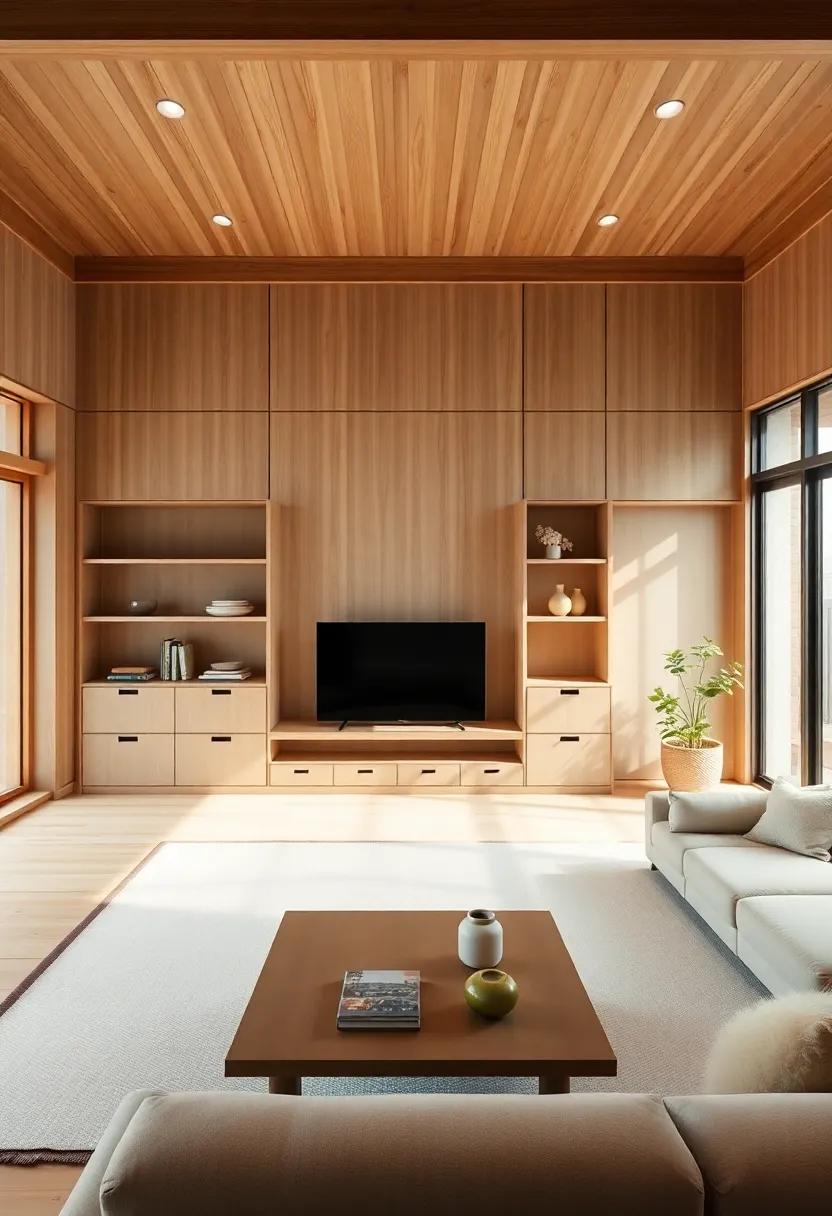
Embracing simplicity can transform your living space into a haven of tranquility. In a Japanese-style living room, the focus is on creating multi-functional areas that are both aesthetic and practical. Consider incorporating low-profile furniture to maintain an open feel while providing adequate seating. Position minimalist shelves strategically to showcase select decorative pieces, books, or plants, allowing for a smooth flow of movement without clutter. Here are some elements to consider:
- Sliding Shoji Screens: Acts as a room divider without consuming space.
- Storage Otomans: Delivers both extra seating and hidden storage.
- Low Tables: Provides a surface for tea or meals, keeping eye levels low for a serene atmosphere.
Achieving balance is crucial in minimalistic design. By relying on a neutral color palette, you can enhance the sense of calmness inherent in Japanese decor. utilize natural materials,such as wood and stone,to connect with nature and create an inviting ambiance. To further illustrate the effectiveness of this approach, consider the following table that highlights essential elements:
| Element | Function |
|---|---|
| natural Textiles | Softens the space and adds warmth. |
| Indoor Plants | Enhances air quality and brings life indoors. |
| Neutral Palette | Promotes a sense of peace and spaciousness. |
Charming Details: Unique Accessories that Enhance Serenity
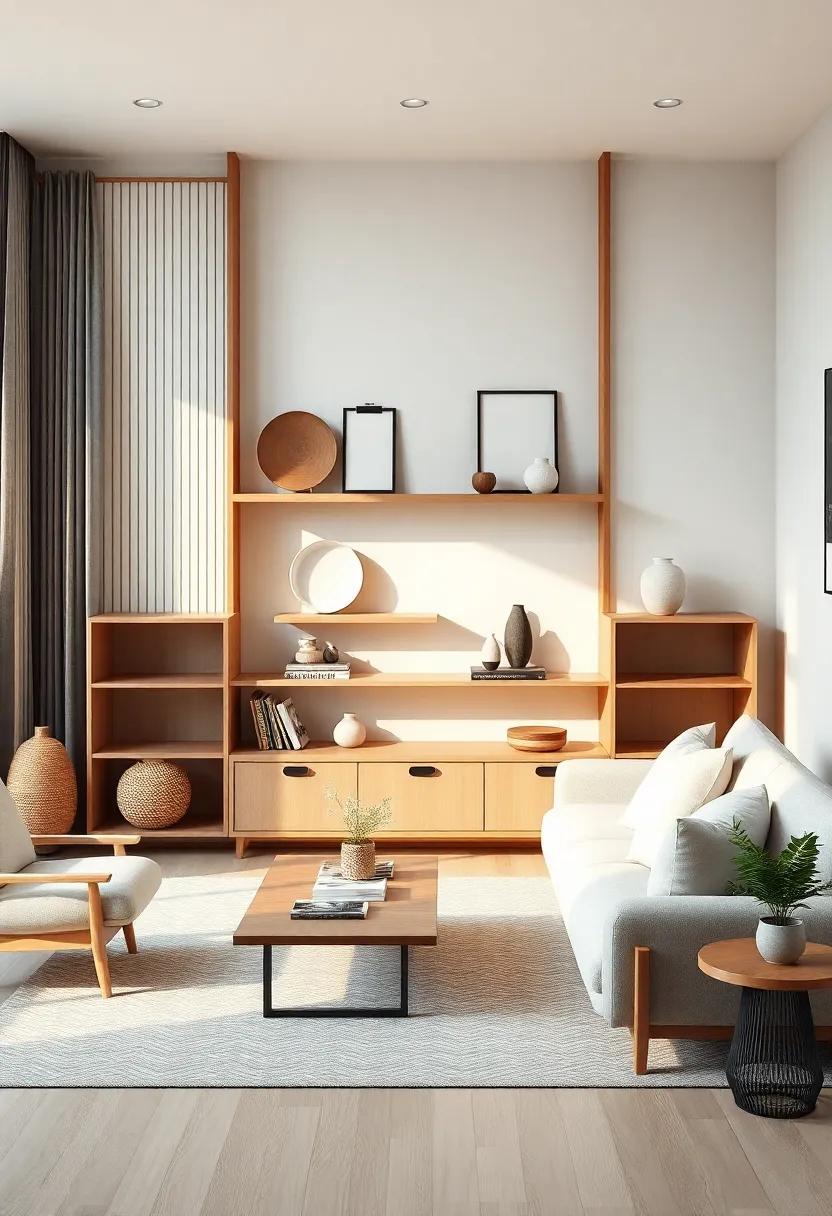
To elevate the tranquility of your Japanese-style living room, consider incorporating accessories that embody simplicity and elegance. Handcrafted ceramic vases, for instance, bring a touch of nature indoors while still adhering to minimalist principles.These functional pieces can hold delicate branches or seasonal flowers, adding organic beauty without overwhelming the serene atmosphere. Additionally, bamboo or rice paper lanterns can softly illuminate your space, creating calming shadows that dance lightly on the walls, thereby enhancing the overall sense of peace.
Another way to instill a sense of calm is through the careful selection of textiles. Fabrics in neutral tones provide warmth without distraction,while woven mats or tatami add a traditional touch that connects to the earth. Incorporating a few simple accessories, such as a stone or wood garden sculpture, can serve as a focal point, drawing the eye towards the essence of nature. To showcase your accessories appropriately, consider designing built-in alcoves or minimalist shelving that allows each piece to breathe, allowing the serene harmony of your living room to flourish.
reflecting in the Design: Mirrors as a Tool for Enhanced Space
Mirrors serve as more than just functional objects; they are transformative elements that can elevate the ambiance of a space, particularly in a Japanese-inspired living room. Strategically placed mirrors can create the illusion of depth, making smaller areas feel more expansive and inviting. When positioning mirrors, consider these points:
- Reflect natural light: Place mirrors across from windows to amplify sunlight, enhancing serenity and warmth.
- Complement minimalist aesthetics: Opt for frames that align with the simplicity of Japanese design, avoiding ornate decorations that disrupt tranquility.
- Focus on calm reflections: Choose mirrors that reflect peaceful views, such as greenery or artistic elements within the room.
Additionally, incorporating mirrors into your shelving can create a seamless flow in the room’s design. By integrating a reflective surface behind minimalist shelves, you can add depth without compromising the clean lines typical of a Japanese-style aesthetic. Utilizing floating shelves with mirrors can also serve dual purposes, both displaying cherished items and enlarging the perception of space. Consider a layout akin to the following:
| Element | Purpose |
|---|---|
| Floating Shelves | Display items while maintaining an unobtrusive look |
| Mirrored Backing | Reflects light and creates a sense of openness |
| Natural Decor | Adds warmth and connects indoors with nature |
The Way Forward
As we draw the curtains on our exploration of crafting a Japanese-style living room with minimalist shelves, it’s clear that the essence of this design transcends mere aesthetics. It embodies a philosophy of simplicity, tranquility, and intentionality that seeks to ground us in our surroundings.By embracing the principles of minimalism, you invite a sense of peace and clarity into your home—a retreat from the chaotic pace of modern life.
As you envision your own serene sanctuary, consider the delicate balance between form and function.Each piece, each shelf, and every item you choose should resonate with purpose, telling a story while inviting calm into your space. Remember, true serenity lies not just in what we include in our living environments, but also in what we choose to leave out.
designing your Japanese-style living room is a personal journey—a chance to curate a space that reflects your values and nurtures your spirit. So take a deep breath, choose wisely, and let the art of simplicity transform your home into a haven of tranquility. Embrace the beauty of less, and watch as it opens the door to a more serene way of living.
As an Amazon Associate I earn from qualifying purchases.



